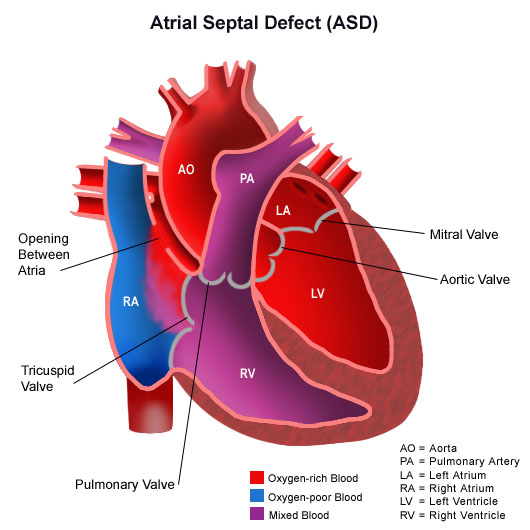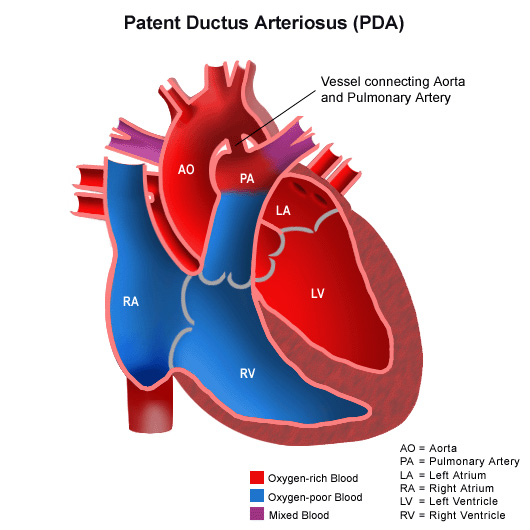What is Congenital Heart Disease?
What is Congenital Heart Disease?Congenital heart disease or defect is a malformation of the heart that is present at birth. It is a problem with the heart’s structure — its walls, valves, arteries, and veins near the heart. These deformities affect the way blood moves through the heart. Although severe abnormalities are life-threatening, congenital heart disease often has few or no symptoms and is not diagnosed until a child is older. Sometimes symptoms don’t become a problem until adulthood.
Types of Congenital Heart Disease
TypesNewYork-Presbyterian provides comprehensive, lifelong care for the following types of congenital heart disease:
- Atrial septal defect. An opening in the wall between the right and left atria (chambers of the heart) results in abnormal blood flow through the heart. Left untreated, atrial septal defects can cause enlargement of the right side of the heart, arrhythmias (irregular heart rhythm), and, in some cases, pulmonary hypertension.
- Atrioventricular canals. Large openings between the right and left sides of the heart. Usually, one large common valve replaces the normal mitral valve and tricuspid valve. Left untreated, this defect can cause poor growth, malnourishment, enlargement of the heart, and pulmonary hypertension.
- Coarctation of the aorta. A constriction in the aorta causes blood pressure to rise above the narrowed area while limiting blood flow to the body.
- Ebstein’s anomaly. This disorder involves the tricuspid valve, which separates the right upper chamber (right atrium) from the right lower chamber (right ventricle) of the heart. The valve’s “leaflets,” which normally open to allow blood to flow from the upper to lower chamber and close to prevent it from flowing backward, do not function properly. Blood may backflow into the upper chamber and cause swelling in the heart and/or fluid buildup in the lungs or liver.
- Hypoplastic left heart syndrome. The left side of the heart is incompletely formed. This deformity is typically repaired with a technique known as the Norwood procedure. Our congenital heart surgeons are among the most experienced in the country performing this procedure, and we achieve some of the best outcomes.
- Patent ductus arteriosus. Ductus arteriosus is a vessel that allows blood to bypass a baby’s lungs before birth. Within a few days after birth, the vessel typically closes. But in babies with patent ductus arteriosus, the vessel remains open and interferes with blood flow between the aorta and pulmonary artery.
- Pulmonary artery stenosis. A narrowing of the pulmonary artery, which carries blood into the lungs so that it may be infused with oxygen. Without enough oxygen-rich blood, the body cannot function properly. To overcome the lack of oxygen-rich blood, the heart tries to push more blood through the pulmonary artery, which can raise pressure in the right ventricle and damage the heart.
- Single ventricle. Single ventricle is a collective term to describe defects such as hypoplastic left heart syndrome, in which oxygen-rich and oxygen-poor blood mix in a single chamber of the heart. Our heart surgeons have great expertise in performing the Fontan procedure, which directs oxygen-poor blood to the pulmonary artery and lungs. We provide lifelong care for people born with single ventricle disorders.
- Sinus of Valsalva aneurysm. A ruptured sinus of Valsalva aneurysm causes communication between the aorta and the atrium or right ventricle. This abnormality is often congenital but may also result from endocarditis (inflammation of the heart’s inner lining) or trauma. Surgery is the recommended treatment and requires special expertise, such as that found at NewYork-Presbyterian.
- Tetralogy of Fallot. The most common cyanotic defect (where the heart delivers less oxygen-rich blood to the body than normal), this complex congenital condition consists of four developmental malformations which need to be surgically repaired early in childhood. Many people with this disorder also need the pulmonary valve replaced when they are adults. We are renowned for our experience treating patients with Tetralogy of Fallot.
- Transposition of the great arteries. The anatomical positions of the pulmonary artery and aorta are switched, so that the aorta arises from the right ventricle and the pulmonary artery arises from the left ventricle. This causes oxygen-poor blood to be circulated to the body instead of oxygen-rich blood, causing a life-threatening medical emergency that requires immediate treatment. Our surgeons have pioneered the innovative “arterial switch procedure,” which recreates normal anatomy and function while reducing the risk of complications associated with other surgeries.
- Valve repair and re-repair. People who had valve repair surgery for congenital heart defects as children often require another surgical repair or replacement as adults. Our surgeons have exceptionally high experience performing these procedures. Examples include repair or replacement of the aortic valve in patients with congenital aortic stenosis or other disorders affecting this valve and repair or replacement of the pulmonary valve in people with pulmonary atresia (a form of heart disease in which the pulmonary valve does not form properly).
- Ventricular septal defect. An opening in the wall that separates the two ventricles of the heart, causing oxygen-poor blood to mix with oxygen-rich blood. Our surgeons are highly skilled in correcting these defects, using robotic surgery for some patients.
Signs & Symptoms of Congenital Heart Disease
SymptomsMany adults with congenital heart defects have been treated as children, but symptoms can return later in life. For others, signs of a never-treated heart malformation may appear in adulthood. In both cases, common symptoms of congenital heart disease in adults include:
- Irregular heart rhythms (arrhythmias)
- Shortness of breath
- Fatigue, tiring easily with exercise
- Heart failure
- Stroke
- High blood pressure in the lung arteries (pulmonary hypertension)
- Blue skin, lips, and fingernails (cyanosis)
What Causes Congenital Heart Disease?
CausesCongenital heart disease happens when something disrupts the normal development of the heart in utero. Often this takes place during the first six weeks of pregnancy. In most cases, doctors don’t know what causes congenital heart disease. Sometimes it is inherited (runs in families). Certain genetic conditions are associated with high rates of congenital heart defects, including Down’s syndrome, Turner syndrome, and Noonan syndrome.
Risk Factors for Congenital Heart Disease
Risk FactorsThe specific cause of congenital heart disease is usually not known. But certain risk factors increase the chances of malformations during the heart’s development, including:
- Smoking during pregnancy
- Drinking alcohol during pregnancy
- Rubella (German measles) during the first 8 to 10 weeks of pregnancy
- Type 1 or type 2 diabetes (but not gestational diabetes)
- Flu (influenza) during the first three months of pregnancy
- Taking certain medicines, including some for seizures and acne
- Family history of congenital heart disease (inherited)
- Genetic conditions, including Down’s, Turner, and Noonan syndromes
Trust NewYork-Presbyterian for Congenital Heart Disease Care
Learn more about our renowned surgical expertise and other treatment options available for congenital heart disease care. NewYork-Presbyterian’s exceptional cardiac care team provides treatment for all heart diseases and disorders, including aortic disease and heart failure. We also offer specialized services, including interventional cardiology and heart transplantation.





